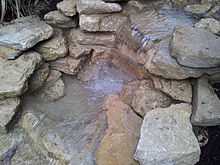Artificial waterfall


An artificial waterfall is a water feature or fountain which imitates a natural waterfall.[1]
Artificial waterfalls have long been featured in traditional Japanese gardens, where they can serve to highlight a scene or to provide focus. The classic gardening manual Sakuteiki, written in the mid-to-late 11th century, lists nine different types.[2][3]
Artificial waterfalls were popular in Europe in the late 19th and early 20th centuries, including the famous waterfall in Viktoriapark in Berlin.[1] An early American example is Huntington Waterfalls in Golden Gate Park, San Francisco, California. In 1896, Gardening Magazine reported that it was the only artificial waterfall in a public park in North America.[4]
Indoor waterfalls

Artificial waterfalls installed inside of buildings can be small or quite large. Some of the benefits of indoor waterfalls are considered to be their production of white noise, humidity, negative ions, as well as naturally peaceful feelings engendered among onlookers.[5]
Examples
- Cascata delle Marmore in Umbria, Italy was first built by the ancient Romans.
- Jurong Falls is 30 metres (98 ft) tall, and is located within the open-access Waterfall Aviary at the Jurong Bird Park in Singapore.
-
Chater Garden in Hong Kong
-
Artificial waterfall and sculpture at a transportation company in Salzburg
-
FDR Memorial in Washington D.C.
References
| Wikimedia Commons has media related to Artificial waterfalls. |
- ↑ 1.0 1.1 Susan C. Anderson (Editor), Bruce Tabb (Editor), Water, Leisure and Culture: European Historical Perspectives, Berg Publishers, 2002, ISBN 1859735401, page 122
- ↑ Takei, Jiro et al. (2001). Sakuteiki Visions of the Japanese Garden: A Modern Translation of Japan's Gardening Classic, p. 3 n1
- ↑ David Young, Michiko Young, The Art of the Japanese Garden, Tuttle Publishing, 2005, ISBN 0804835985, page 30
- ↑ Gardening Magazine, 1896, page 363
- ↑ Zen & the Art of Pond Building, D. J. Herda, Sterling Publishing Company, Inc., 2008, ISBN 1402742746, page 9


